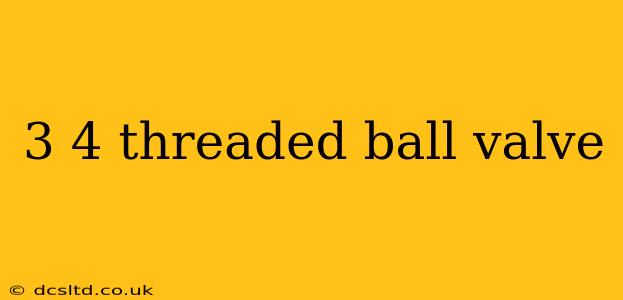Choosing the right valve for your plumbing or industrial application is crucial. This guide delves into the specifics of 3/4" threaded ball valves, exploring their features, applications, and considerations for selection. We'll cover everything you need to know to make an informed decision.
What is a 3/4" Threaded Ball Valve?
A 3/4" threaded ball valve is a type of quarter-turn valve with a spherical "ball" at its core. This ball has a hole bored through it, which allows for fluid flow when aligned with the valve's inlet and outlet ports. The "3/4"" refers to the nominal pipe size—the valve's threaded connections are sized to fit 3/4" pipes. The threaded design allows for easy installation and removal by screwing the valve directly onto threaded pipe fittings.
How Does a 3/4" Threaded Ball Valve Work?
The operation is simple and efficient: turning the valve handle a quarter-turn (90 degrees) opens or closes the flow path completely. This rapid on/off action makes them ideal for applications needing quick control. The ball's rotation aligns the bore with the flow path (open) or seals it off (closed) with a tight seal, preventing leakage.
What are the Different Types of 3/4" Threaded Ball Valves?
Several variations exist, catering to different needs and applications:
- Material: Common materials include brass (for general plumbing), stainless steel (for corrosion resistance), and PVC (for chemical compatibility). The chosen material impacts durability, corrosion resistance, and suitability for specific fluids.
- Handle Type: Lever handles are common for ease of use, while some industrial applications may utilize more robust wheel handles.
- End Connections: While this guide focuses on threaded connections, variations exist with compression fittings, solder connections, and others.
- Port Type: Full-port valves provide unrestricted flow, minimizing pressure drop, whereas reduced-port valves have a smaller flow path.
What are the Applications of 3/4" Threaded Ball Valves?
Their versatility makes them suitable for a broad range of applications:
- Residential Plumbing: Controlling water flow to appliances, fixtures, or garden hoses.
- Industrial Processes: On/off control of various fluids in manufacturing and processing plants.
- Irrigation Systems: Managing water flow in agricultural and landscape irrigation.
- Compressed Air Systems: Controlling the flow of compressed air in industrial settings.
- Chemical Handling: (Material dependent) Depending on the valve's material, it can handle specific chemicals.
What are the Advantages of Using a 3/4" Threaded Ball Valve?
Several key advantages contribute to their widespread use:
- Simple Operation: Quick quarter-turn operation for easy on/off control.
- Compact Design: They occupy minimal space, ideal for tight installations.
- Tight Seal: Typically provide a leak-free seal when properly installed and maintained.
- Durable Construction: Depending on the material, they can withstand considerable pressure and wear.
- Cost-Effective: Generally, they are a cost-effective solution compared to other valve types.
How Do I Choose the Right 3/4" Threaded Ball Valve?
Careful consideration is necessary to select the appropriate valve:
- Fluid Compatibility: Ensure the valve material is compatible with the fluid being controlled. Check for chemical resistance.
- Pressure Rating: The valve's pressure rating must exceed the maximum pressure the system will experience.
- Temperature Rating: Verify the valve's ability to withstand the operating temperature range.
- Flow Rate: Consider the required flow rate to select a full-port valve if minimal pressure drop is crucial.
- Installation Space: Ensure there's sufficient space for valve installation and operation.
What is the Difference Between a 3/4" Threaded Ball Valve and a 3/4" Threaded Gate Valve?
While both are used for flow control, they differ in their mechanism and operation. Ball valves offer quarter-turn on/off control, while gate valves require a longer, linear movement to open or close completely. Ball valves are generally more compact and quicker to operate, while gate valves may offer better flow control at partially open positions.
How Do I Maintain a 3/4" Threaded Ball Valve?
Regular maintenance ensures longevity and prevents leaks:
- Periodic Inspection: Check for leaks, corrosion, or damage.
- Lubrication: Lubricate the valve stem periodically according to the manufacturer's recommendations to reduce friction and ensure smooth operation.
- Cleaning: Clean the valve externally to remove dirt or debris.
This comprehensive guide provides a solid foundation for understanding and selecting the appropriate 3/4" threaded ball valve for your specific needs. Remember to always consult manufacturer specifications and safety guidelines when installing and using any valve.
